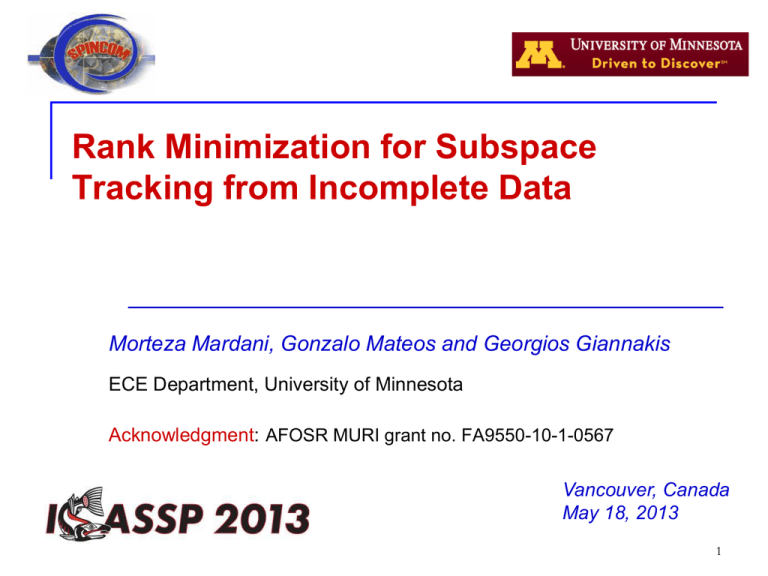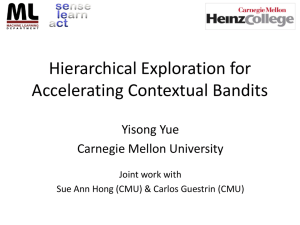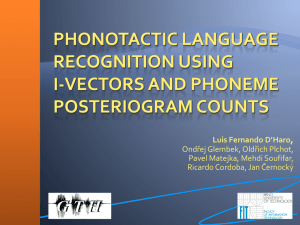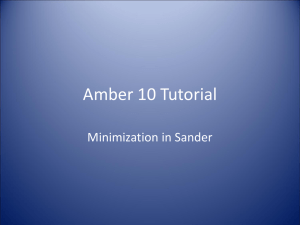Goal
advertisement

Rank Minimization for Subspace Tracking from Incomplete Data Morteza Mardani, Gonzalo Mateos and Georgios Giannakis ECE Department, University of Minnesota Acknowledgment: AFOSR MURI grant no. FA9550-10-1-0567 Vancouver, Canada May 18, 2013 1 Learning from “Big Data” `Data are widely available, what is scarce is the ability to extract wisdom from them’ Hal Varian, Google’s chief economist BIG Fast Ubiquitous Productive Smart Messy Revealing K. Cukier, ``Harnessing the data deluge,'' Nov. 2011. 2 Streaming data model Preference modeling Incomplete observations ? ? ? ? ? ? ? ? Sampling operator: lives in a slowly-varying low-dimensional subspace Goal: Given and estimate and recursively 3 Prior art (Robust) subspace tracking Projection approximation (PAST) [Yang’95] Missing data: GROUSE [Balzano et al’10], PETRELS [Chi et al’12] Outliers: [Mateos-Giannakis’10], GRASTA [He et al’11] Batch rank minimization Nuclear norm regularization [Fazel’02] Exact and stable recovery guarantees [Candes-Recht’09] Novelty: Online rank minimization Scalable and provably convergent iterations Attain batch nuclear-norm performance 4 Low-rank matrix completion Consider matrix , set Sampling operator Given incomplete (noisy) data (as) has low rank Goal: denoise observed entries, impute missing ones Nuclear-norm minimization [Fazel’02],[Candes-Recht’09] 5 Problem statement Available data at time t ? ? ? ? ? ? ? ? ? ? ? ? ? ? Goal: Given historical data , estimate from (P1) Challenge: Nuclear norm is not separable Variable count Pt growing over time Costly SVD computation per iteration 6 Separable regularization Key result [Burer-Monteiro’03] Pxρ New formulation equivalent to (P1) ≥rank[X] (P2) Nonconvex; reduces complexity: Proposition 1. If then stationary pt. of (P2) and is a global optimum of (P1). , 7 Online estimator Regularized exponentially-weighted LS estimator (0 < β ≤ 1 ) (P3) := Ct(L,Q) Alternating minimization (at time t) Step1: Projection coefficient updates Step2: Subspace update := gt(L[t-1],q) 8 Online iterations Attractive features ρxρ inversions per time, no SVD, O(Pρ3) operations (ind. of time) β=1: recursive least-squares; O(Pρ2) operations 9 Convergence As1) Invariant subspace As2) Infinite memory β = 1 Proposition 2: If c1) c2) c3) and and are i.i.d., and is uniformly bounded; is in a compact set; and is strongly convex w.r.t. hold, then almost surely (a. s.) asymptotically converges to a stationary point of batch (P2) 10 Optimality Q: Given the learned subspace is and the corresponding an optimal solution of (P1)? Proposition 3: If there exists a subsequence c1) s.t. a. s. c2) then for (P1) as satisfies the optimality conditions a. s. 11 Numerical tests Optimality (β=1) Algorithm 1, =0.5, 2=10 -2, =1 Data Batch, =0.5, 2=10 -2, =1 0 Algorithm 1, =0.25, 2=10 -3, =0.1 10 , , , Average cost Batch, =0.25, 2=10 -3, =0.1 -1 Performance comparison (β=0.99, λ=0.1) -2 Average estimation error 10 10 10 1 0 (P1) 2000 4000 6000 8000 10000 Iteration index (t) Algorithm 1 GROUSE, =r GROUSE, = PETRELS, =r PETRELS, = 0 (P1) 10 Efficient for large-scale matrix completion Complexity comparison Algorithm 1 O(Pρ3) 10 -1 0 1 2 3 Iteration index (t) 4 5 x 10 PETRELS O(Pρ2) GROUSE O(Pρ) 4 12 Tracking Internet2 traffic Goal: Given a small subset of OD-flow traffic-levels estimate the rest Traffic is spatiotemporally correlated Real network data Dec. 8-28, 2008; N=11, L=41, F=121, T=504 k=ρ=10, β=0.95 π=0.25 10 10 Algorithm 1, =0.25 GROUSE, =0.25 PETRELS, =0.25 Algorithm 1, =0.45 GROUSE, =0.45 PETRELS, =0.45 1 0 x 10 CHIN--IPLS 2 Flow traffic-level Average estimation error 10 4 7 -1 0 2 0 x 10 1000 7 2000 3000 4000 3000 4000 3000 4000 CHIN--LOSA 1 0 2 0 x 10 1000 7 2000 LOSA--ATLA 1 10 -2 0 1000 2000 3000 4000 5000 6000 Iteration index (t) Data: http://www.cs.bu.edu/~crovella/links.html 0 0 1000 2000 Iteration index (t) 13 Dynamic anomalography Estimate a map of anomalies in real time Streaming data model: Goal: Given estimate online when low-dimensional space and is sparse is in a CHIN--ATLA ATLA--HSTN 4 5 0 DNVR--KSCY 20 10 0 HSTN--ATLA 20 Anomaly amplitude Link traffic level 2 0 WASH--STTL ---- estimated ---- real 40 20 0 WASH--WASH 30 20 10 10 0 0 Time index (t) 0 1000 2000 3000 4000 5000 6000 Time index (t) M. Mardani, G. Mateos, and G. B. Giannakis, "Dynamic anomalography: Tracking network anomalies via sparsity and low rank," IEEE Journal of Selected Topics in Signal Process., vol. 7, pp. 50-66, Feb. 2013.14 Conclusions Track low-dimensional subspaces from Incomplete (noisy) high-dimensional datasets Online rank minimization Scalable and provably convergent iterations attaining batch nuclear-norm performance Viable alternative for large-scale matrix completion Extensions to the general setting of dynamic anomalography Future research Accelerated stochastic gradient for subspace update Adaptive subspace clustering of Big Data Thank You! 15











